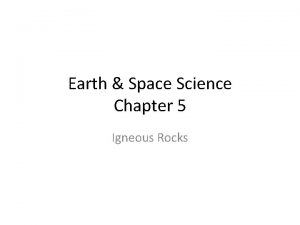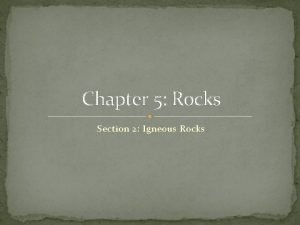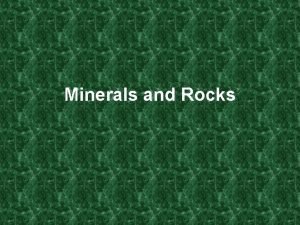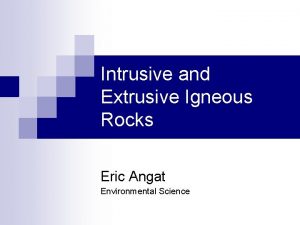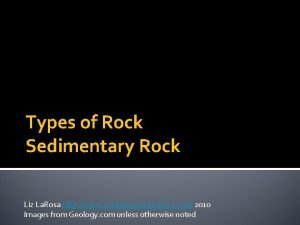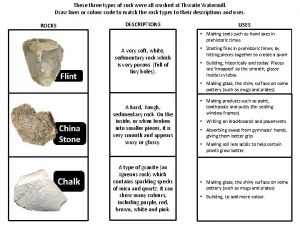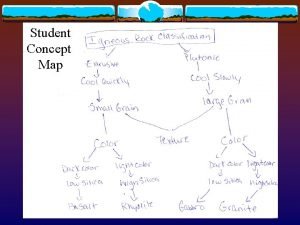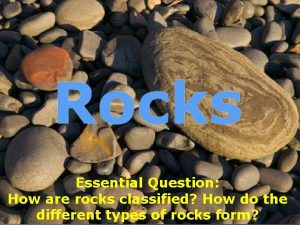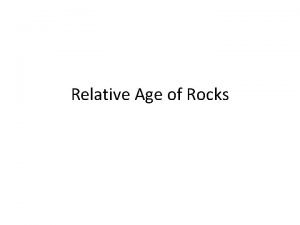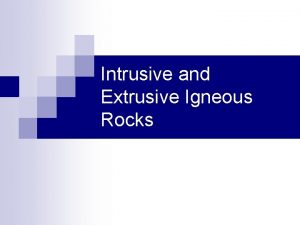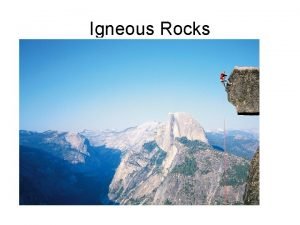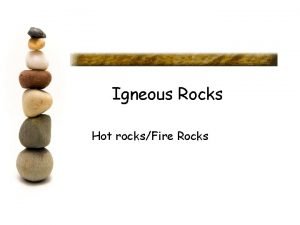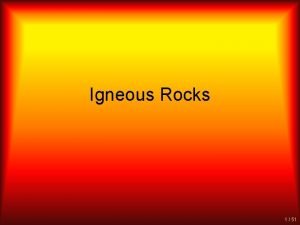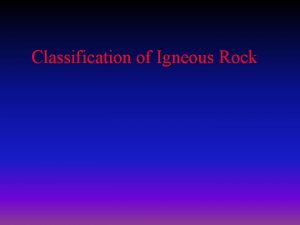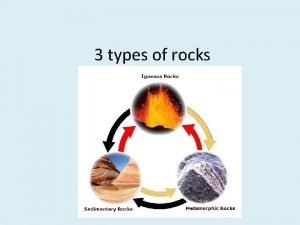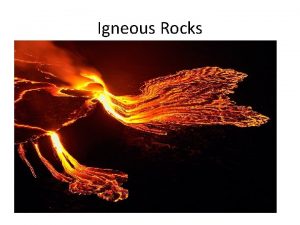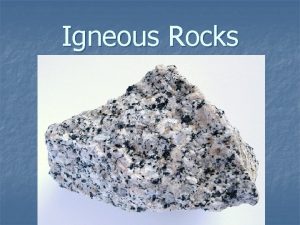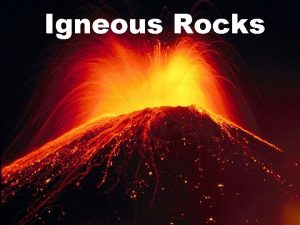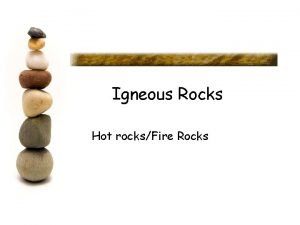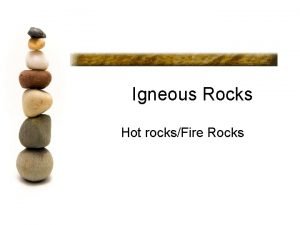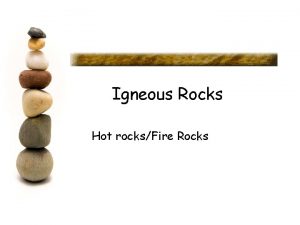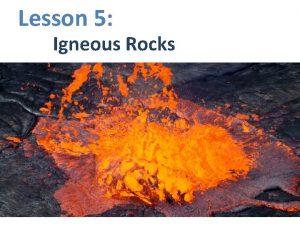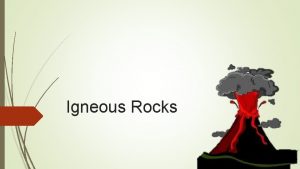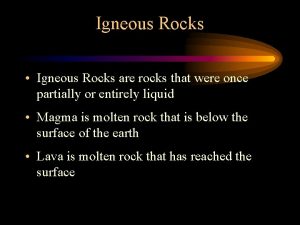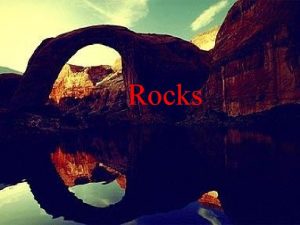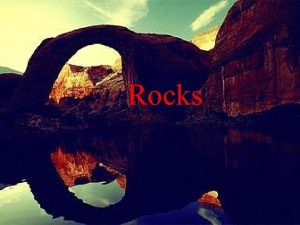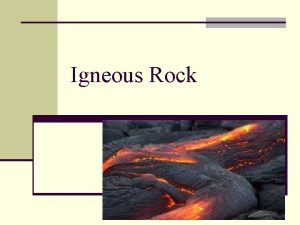Igneous Rocks and Their Origin Chapter 3 The























- Slides: 23

Igneous Rocks and Their Origin Chapter 3

The Rock Cycle • A rock is composed of grains of one or more minerals • The rock cycle shows how one type of rocky material is transformed into another

Three Types of Rocks • Igneous rocks - Formed from volcanic eruptions - either external or internal • Sedimentary rocks - Formed from erosional processes • Metamorphic rocks - Deforming of rocks above from exposure to high pressure and temperature

The Rock Cycle and Plate Tectonics • Magma is created by melting above a subduction zone • Less dense magma rises and cools to form igneous rock • Igneous rock exposed at surface gets weathered into sediment • Sediments transported to low areas, buried and hardened into sedimentary rock • Sedimentary rock heated and squeezed at depth to form metamorphic rock

Igneous Rocks • Magma is molten rock • Igneous rocks form when magma cools and solidifies – Intrusive igneous rocks form when magma solidifies underground Granite • Granite is a common example – Extrusive igneous rocks form when magma solidifies at the Earth’s surface (lava) • Basalt is a common example Basalt

How do we Know Igneous Rocks Formed at Depth? Torres del Paine, Chile • Mineralogy / Chemistry ? • Grain size (coarse vs fine grained) • Lab expmts require high P & T to form large grains • Outcrops: See intrusions into country rock -Contact/chill zones, baked and metamorphosed • Xenoliths of country rock found in igneous intrusions

Igneous Rock Textures • Texture refers to the size, shape and arrangement of grains • Texture of igneous rocks is controlled by cooling rate • Extrusive rocks cool quickly at the Earth’s surface and are fine-grained (small <1 mm) • Intrusive rocks cool slowly deep beneath Earth’s surface and are coarse-grained (large >1 mm) Fine-grained igneous rock Coarse-grained igneous rock

Special Igneous Textures • A pegmatite is a very coarse-grained rock (crystals >5 cm) formed when magma cools very slowly at depth • A glassy texture contains no crystals at all, and is formed by rapid cooling Pegmatitic igneous rock • A porphyritic texture includes two crystal sizes, formed first during slow cooling (large crystal) and then forming small crystals during rapid cooling Porphyritic igneous rock

Igneous Rock Identification • Igneous rock names are based on texture (grain size) and composition Textural classification • – – • Coarse-grained: Plutonic rocks (gabbro-diorite-granite) cooled slowly at depth Fine-Grained: Volcanic rocks (basalt-andesite-rhyolite) cooled rapidly at the Earth’s surface Compositional classification – – – Mafic rocks (gabbro-basalt) contain dark-colored ferromagnesian minerals, iron rich (50% silica) Intermediate rocks (diorite-andesite) contain roughly equal amounts of dark- and light-colored minerals Felsic rocks (granite-rhyolite) light-colored minerals, silica rich (65%)

Igneous Rock Identification Olivine Igneous names are based on 1) texture and 2) mineralogic composition

Intrusive Rock Bodies • Intrusive rocks exist in bodies or structures that penetrate or cut through pre-existing country rock • Shallow intrusions: Dikes and sills • • Form <2 km beneath Earth’s surface Chill and solidify quickly in cool country rock

Intrusive Rock Bodies • Plutons: deep magmatic intrusions - Form at considerable depth beneath the surface when rising blobs of magma (diapirs) get trapped within the crust

Pluton in Ship Rock, New Mexico

Intrusive Rock Bodies • Volcanic neck – • Shallow intrusion formed when magma solidifies in throat of volcano Dike – • Light-colored dikes Tabular intrusive structure that cuts across any layering in country rock Sill – Tabular intrusive structure that parallels layering in country rock Basaltic sill Sierra Nevada batholith

How Magma Forms Heat from below • • • Melting Temp (Tm) of granite is 650 o. C and basalt is 1000 o. C Geothermal gradient: Rate at which temperature increases with depth beneath the surface is 30 o/km Volcanic geotherm is higher due to rise of hot magma, gases (water), or composition change Granite melting T = 650 o C

Melting Temperature can be Effected by: Increasing temperature Decrease in pressure Addition of water Mixed mineral composition

Melting Temperature can be Effected by: • Heat vs. pressure – – Melting point of minerals generally increases with increasing pressure Decompression melting can occur when hot mantle rock moves upward and pressure is reduced enough to drop melting point to the temperature of the rising rock body

. . . Melting Temperature • Hot water under pressure – – • Water becomes increasingly reactive at higher temperatures Highly reactive water vapor can reduce the melting point of rocks by over 200°C Mineral mixtures – Mixtures of minerals, such as quartz and potassium feldspar, can result in the melting of both at temperatures hundreds of degrees lower than either mineral would melt on its own Insert new Fig. 3. 18 here

Magma Melting Mixed magmas may have a lower melting temperature than either alone.

Magma Crystallization and Melting Sequence Bowen's Reaction Series • Minerals crystallize in a predictable order (and melt in the reverse order) • Minerals crystallize in sequence with decreasing temperature olivine pyroxene amphibole biotite feldspars quartz Bowen’s Reaction Series

Lessons from Bowen’s Reaction Series • Variety of igneous rocks is produced by variety of magma compositions • • Mafic magmas will crystallize into basalt or gabbro Intermediate magmas will similarly crystallize into diorite or andesite if minerals are not removed • Minerals melt in the reverse order of that in which they crystallize from a magma

Igneous Activity and Plate Tectonics • Igneous activity occurs primarily at or near tectonic plate boundaries • Divergent boundaries: typically produce mafic igneous rocks – – • Increased heat flow Decompression melting at spreading centers Convergent boundaries: typically produce intermediate igneous rocks – – High pressures and high temperatures induce melting Water release melting occurs above subduction zones (andesite, granite)

Igneous Activity and Plate Tectonics • Felsic igneous rocks are commonly formed adjacent to convergent boundaries – • Hot rising magma causes partial melting of the granitic continental crust Intraplate volcanism – – Rising mantle plumes can produce localized hotspots and volcanoes when they produce magmas that rise through oceanic or continental crust Hawaii is an example
 Sedimentary rock song
Sedimentary rock song Igneous metamorphic and sedimentary
Igneous metamorphic and sedimentary Chapter 5 igneous rocks
Chapter 5 igneous rocks Chapter 5 igneous rocks
Chapter 5 igneous rocks Luster and streak
Luster and streak Is igneous rock intrusive or extrusive
Is igneous rock intrusive or extrusive Venn diagram of intrusive and extrusive igneous rocks
Venn diagram of intrusive and extrusive igneous rocks Concept map of major types of rocks
Concept map of major types of rocks Parent rock sedimentary
Parent rock sedimentary Concept map for igneous rocks
Concept map for igneous rocks What is massive igneous rock
What is massive igneous rock Characteristics of igneous rocks
Characteristics of igneous rocks Concept map about rocks
Concept map about rocks Wedcc anchor chart
Wedcc anchor chart Principle of inclusions
Principle of inclusions Intrusive rock definition
Intrusive rock definition Rock cycle
Rock cycle Pumice crystal size
Pumice crystal size Extrusive rocks and intrusive rocks
Extrusive rocks and intrusive rocks Ultrabasic rocks
Ultrabasic rocks What is igneous rock
What is igneous rock Concept map for igneous rocks
Concept map for igneous rocks Iugs classification of igneous rocks
Iugs classification of igneous rocks How are rocks formed
How are rocks formed


